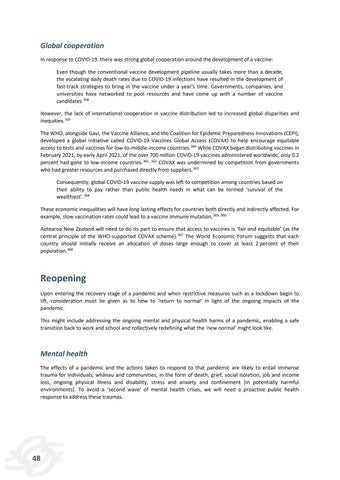Global cooperation In response to COVID-19, there was strong global cooperation around the development of a vaccine: Even though the conventional vaccine development pipeline usually takes more than a decade, the escalating daily death rates due to COVID-19 infections have resulted in the development of fast-track strategies to bring in the vaccine under a year’s time. Governments, companies, and universities have networked to pool resources and have come up with a number of vaccine candidates. 358 However, the lack of international cooperation in vaccine distribution led to increased global disparities and inequities. 359 The WHO, alongside Gavi, the Vaccine Alliance, and the Coalition for Epidemic Preparedness Innovations (CEPI), developed a global initiative called COVID-19 Vaccines Global Access (COVAX) to help encourage equitable access to tests and vaccines for low-to-middle-income countries. 360 While COVAX began distributing vaccines in February 2021, by early April 2021, of the over 700 million COVID-19 vaccines administered worldwide, only 0.2 percent had gone to low-income countries. 361, 362 COVAX was undermined by competition from governments who had greater resources and purchased directly from suppliers. 363 Consequently, global COVID-19 vaccine supply was left to competition among countries based on their ability to pay rather than public health needs in what can be termed ‘survival of the wealthiest’. 364 These economic inequalities will have long lasting effects for countries both directly and indirectly affected. For example, slow vaccination rates could lead to a vaccine immune mutation. 365, 366 Aotearoa New Zealand will need to do its part to ensure that access to vaccines is ‘fair and equitable’ (as the central principle of the WHO-supported COVAX scheme). 367 The World Economic Forum suggests that each country should initially receive an allocation of doses large enough to cover at least 2 percent of their population. 368
Reopening Upon entering the recovery stage of a pandemic and when restrictive measures such as a lockdown begin to lift, consideration must be given as to how to ‘return to normal’ in light of the ongoing impacts of the pandemic. This might include addressing the ongoing mental and physical health harms of a pandemic, enabling a safe transition back to work and school and collectively redefining what the ‘new normal’ might look like.
Mental health The effects of a pandemic and the actions taken to respond to that pandemic are likely to entail immense trauma for individuals, whānau and communities, in the form of death, grief, social isolation, job and income loss, ongoing physical illness and disability, stress and anxiety and confinement (in potentially harmful environments). To avoid a ‘second wave’ of mental health crises, we will need a proactive public health response to address these traumas.
48


